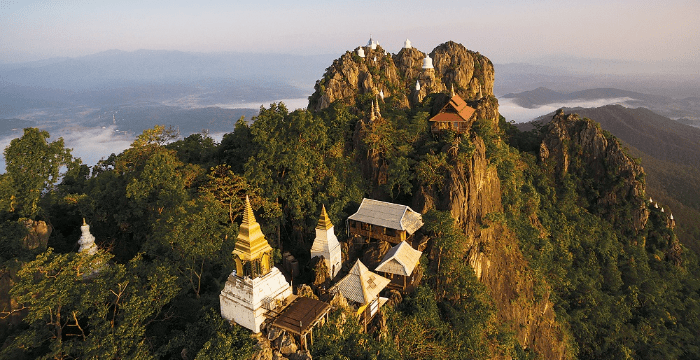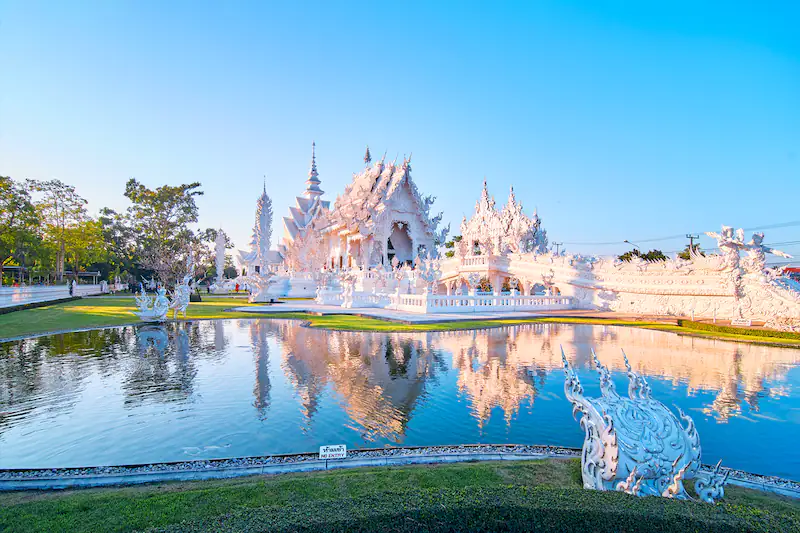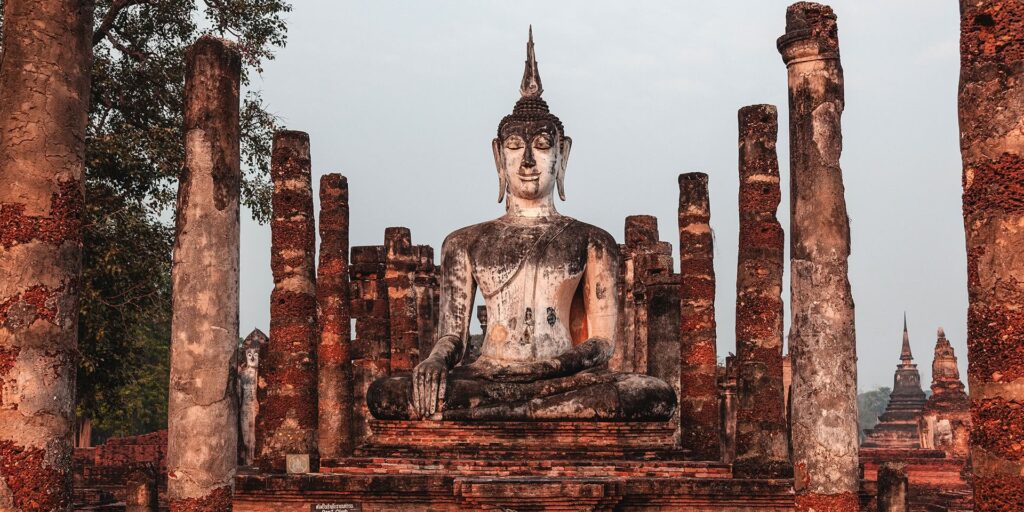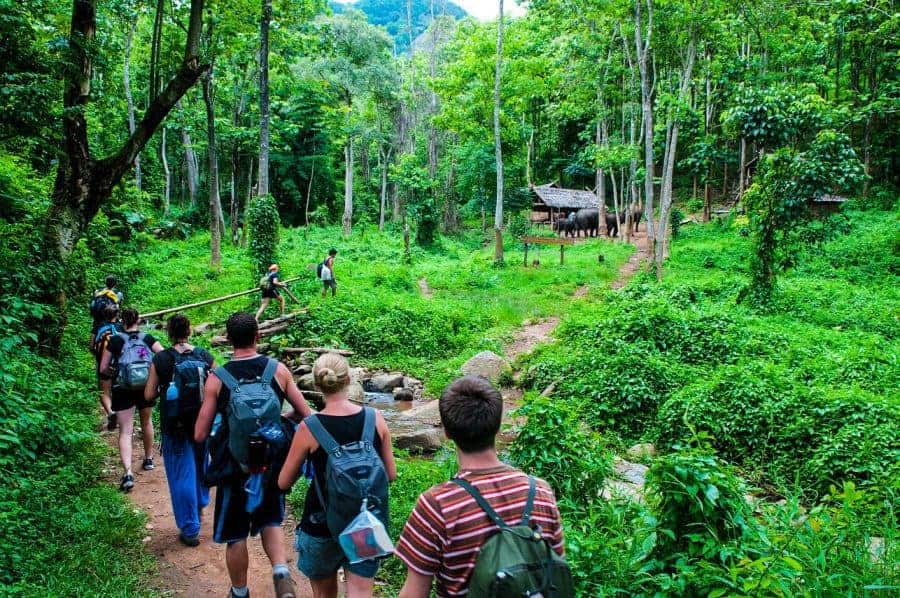Chiang Mai, often referred to as the “Rose of the North,” is a captivating city nestled in the heart of Northern Thailand. With its rich cultural heritage, stunning natural landscapes, and vibrant urban life, Chiang Mai is a destination that offers travelers a unique blend of experiences. In this chapter, we will provide you with an overview of Chiang Mai’s culture, geography, and why it serves as an ideal base for exploring the wonders of Northern Thailand.
Chiang Mai’s Culture and Heritage
A Glimpse into the Past
Chiang Mai boasts a history that dates back over 700 years. Founded in 1296 as the capital of the Lanna Kingdom, the city has witnessed centuries of cultural evolution and development. This rich history is reflected in the city’s architecture, temples, and traditions.
Temples and Spirituality
Chiang Mai is often referred to as the “City of Temples,” and for good reason. The city is home to over 300 Buddhist temples, each with its own unique charm and significance. The most iconic of these temples is Wat Phra Singh, known for its intricate architecture and revered Buddha image. These temples provide a serene and spiritual atmosphere that is deeply ingrained in the local way of life.
Festivals and Celebrations
The city also comes alive with vibrant festivals and celebrations throughout the year. The Yi Peng Lantern Festival and Loy Krathong, celebrated in November, are world-famous for their mesmerizing lantern releases and riverbank ceremonies. Songkran, the Thai New Year, is celebrated with water fights and cultural festivities in April. These festivals offer a glimpse into the warmth and hospitality of the local people.
Geography of Chiang Mai
Lush Mountainous Terrain
Chiang Mai is situated in a valley surrounded by lush mountains, making it a visual delight for nature enthusiasts. The towering Doi Suthep Mountain overlooks the city, offering breathtaking panoramic views. Beyond the city limits, Northern Thailand is characterized by its pristine forests, serene lakes, and meandering rivers.
Unique Climate
The region experiences a tropical wet and dry climate, with distinct seasons. The cool season (November to February) is the most popular time to visit when the weather is pleasantly mild. The hot season (March to May) brings warmer temperatures, while the rainy season (June to October) rejuvenates the landscape with lush greenery.
Exploring Northern Thailand from Chiang Mai
A Hub for Adventure
Chiang Mai serves as an ideal base for exploring Northern Thailand due to its strategic location and excellent infrastructure. Whether you’re interested in trekking through dense jungles, visiting remote hill tribes, or embarking on cultural journeys, Chiang Mai offers a wide range of excursions and activities.
Rich Cultural Diversity
Northern Thailand is known for its diverse ethnic communities, each with its own language, traditions, and cuisines. Exploring the region allows you to interact with local hill tribes such as the Karen, Hmong, and Lisu, gaining insights into their way of life.
Culinary Delights
Northern Thai cuisine is renowned for its distinctive flavors and aromatic dishes. From savory khao soi to spicy nam prik num, the region’s culinary offerings are a delight for food lovers. Chiang Mai’s bustling markets and street food stalls are perfect places to savor these local delicacies.
The Uniqueness of Northern Thailand
Hidden Gems
Beyond Chiang Mai, Northern Thailand is dotted with hidden gems waiting to be discovered. These include serene waterfalls, sacred caves, and remote villages. The region’s off-the-beaten-path destinations offer an authentic and immersive travel experience.
Breathtaking Scenery
Northern Thailand’s natural beauty is awe-inspiring. Whether you’re trekking in the dense jungles of Chiang Dao or cruising along the serene waters of Phayao Lake, the region’s scenery is diverse and captivating.
Warmth of the People
What truly sets Northern Thailand apart is the warmth and friendliness of its people. The locals, known for their genuine hospitality, welcome travelers with open arms. Engaging with the local communities is a rewarding aspect of exploring this region.
In summary, Chiang Mai and Northern Thailand offer a unique blend of cultural richness, natural beauty, and adventure. With its vibrant culture, stunning landscapes, and friendly locals, this region is a treasure trove for travelers seeking an unforgettable experience. Whether you’re exploring ancient temples, trekking through the mountains, or savoring delicious cuisine, Chiang Mai is the gateway to the wonders of Northern Thailand.


Journey from Chiang Mai to Lampang
Nestled in the heart of Northern Thailand, the historic city of Lampang is a gem waiting to be explored. Located just a few hours’ drive from Chiang Mai, the journey to Lampang is an adventure in itself. As you leave Chiang Mai behind, you’ll find yourself immersed in the picturesque landscapes of Northern Thailand. The scenic drive takes you through rolling hills, lush forests, and charming villages, providing a glimpse of the region’s natural beauty.
Key Attractions in Lampang
Wat Phra That Lampang Luang
One of Lampang’s most iconic attractions is the ancient temple of Wat Phra That Lampang Luang. This majestic temple dates back over 1,300 years and is a stunning example of Lanna architecture. Surrounded by a protective wall and nestled amidst lush greenery, the temple exudes an air of tranquility and spirituality. As you explore its intricate designs, ornate decorations, and towering pagodas, you’ll be transported back in time to a bygone era of Thai history.
Thai Elephant Conservation Center
Lampang is renowned for its deep connection with elephants. The Thai Elephant Conservation Center, located just outside the city, offers a unique opportunity to get up close and personal with these magnificent creatures. Here, you can witness elephants in their natural habitat, learn about their conservation efforts, and even participate in activities like elephant bathing and feeding. It’s an experience that not only educates but also fosters a deep appreciation for these gentle giants.
Local Cuisine and Cultural Experiences
Delightful Dining
Lampang is a paradise for food enthusiasts. The city’s culinary scene is characterized by its unique blend of Northern Thai and Burmese influences. Don’t miss the chance to savor local delicacies like “khao soi nuea” (beef curry noodles) and “khao kan chin” (steamed rice with pork). Lampang’s night markets come alive with food stalls offering a tantalizing array of dishes that will satisfy your taste buds.
Horse-Drawn Carriages
Lampang is famous for its charming horse-drawn carriages, which have become a symbol of the city. Taking a leisurely ride through Lampang’s historic streets in one of these traditional carriages is a delightful way to explore the city’s heritage. You’ll pass by old wooden houses, colonial-era architecture, and serene temples while enjoying the rhythmic clip-clop of the horses’ hooves.
Cultural Heritage
Lampang’s rich cultural heritage is evident in its well-preserved architecture and traditions. Explore the old town area to discover centuries-old wooden houses with intricate carvings and unique designs. Visit local workshops where artisans craft traditional ceramics and pottery. The city’s museums and cultural centers offer insights into Lampang’s history and artistic heritage.
In conclusion, Lampang is a city steeped in history, culture, and natural beauty. Its proximity to Chiang Mai makes it an accessible destination for a day trip or an extended stay. Whether you’re exploring ancient temples, bonding with elephants, savoring local cuisine, or immersing yourself in Lampang’s unique traditions, this charming city promises a memorable and enriching experience.


The Natural Wonders of Chiang Rai
Traveling from Chiang Mai to Chiang Rai
Nestled in the northernmost part of Thailand, Chiang Rai beckons travelers with its natural beauty and cultural treasures. If you’re starting your journey from Chiang Mai, you’re in for a scenic adventure. The road trip to Chiang Rai offers breathtaking views of Northern Thailand’s countryside, with its rolling hills, lush forests, and winding rivers. Along the way, you’ll have the opportunity to stop at charming villages and roadside markets, making the journey as rewarding as the destination itself.
Exploring the White Temple (Wat Rong Khun)
Chiang Rai’s most iconic attraction is undoubtedly the White Temple, known as Wat Rong Khun. This dazzling masterpiece is unlike any other temple you’ve ever seen. The entire structure is coated in white plaster and adorned with intricate, reflective glass mosaics that glisten in the sunlight. As you approach the temple, you’ll be greeted by a sea of outreaching hands, symbolizing desire and attachment. Crossing the bridge over the “cycle of rebirth” takes you into the temple’s interior, where you’ll find surreal and thought-provoking murals that blend traditional Buddhist themes with modern pop culture references.
Discovering the Blue Temple (Wat Rong Suea Ten)
After the ethereal beauty of the White Temple, make your way to the Blue Temple, or Wat Rong Suea Ten. This newer addition to Chiang Rai’s temple scene is no less impressive. The vibrant blue exterior, adorned with intricate stucco designs and golden accents, creates a sense of serenity and wonder. Inside, you’ll find a stunning white Buddha statue and mesmerizing murals that depict scenes from Buddhist mythology. The Blue Temple is a place of tranquility and reflection, offering a stark contrast to the White Temple’s surrealism.
Visiting the Golden Triangle and Ethnic Hill Tribes
A trip to Chiang Rai wouldn’t be complete without exploring the Golden Triangle, a region where Thailand, Laos, and Myanmar converge. This historically significant area was once notorious for its opium trade but has since transformed into a hub of culture and commerce. You can take a boat ride along the Mekong River to witness the meeting point of these three countries.
Chiang Rai is also a gateway to the fascinating world of ethnic hill tribes. You can embark on a trek to visit these communities and gain insights into their unique cultures and traditions. The Karen, Akha, and Lahu tribes are just a few examples of the diverse groups you can encounter. Engage in meaningful interactions, learn about their way of life, and support responsible tourism practices that benefit these communities.
In conclusion, Chiang Rai offers a captivating blend of natural wonders and cultural treasures. The journey from Chiang Mai is an adventure in itself, leading you to the iconic White Temple and Blue Temple, each with its own distinct charm. Exploring the Golden Triangle and connecting with ethnic hill tribes allows you to delve deeper into the region’s rich tapestry of experiences. Chiang Rai is a destination that will leave you in awe of Thailand’s northern beauty and cultural diversity.


The Tranquil Town of Pai
The Scenic Route to Pai from Chiang Mai
If you’re seeking a tranquil escape from the hustle and bustle of Chiang Mai, look no further than the picturesque town of Pai. Nestled in the mountains of Northern Thailand, Pai is renowned for its stunning natural beauty, relaxed atmosphere, and vibrant arts scene. The journey to Pai from Chiang Mai is an adventure in itself, as you wind through the mountains, passing lush forests, winding rivers, and charming villages along the way. The scenic route is dotted with viewpoints that offer breathtaking panoramas, making it a favorite among motorbike enthusiasts and nature lovers.
Pai’s Must-Visit Spots: Pai Canyon, Hot Springs, and Waterfalls
Pai offers a range of attractions that cater to both nature enthusiasts and those seeking a laid-back retreat.
Pai Canyon, also known as Kong Lan, is a geological wonder with narrow ridges and steep drops. The dramatic landscape is especially popular during sunrise and sunset, offering panoramic views of the surrounding countryside.
Pai’s hot springs are another highlight. The thermal pools provide a relaxing soak amid lush greenery. Pamper yourself in the warm mineral-rich waters, which are said to have therapeutic properties.
Waterfalls abound in the Pai area, with Pam Bok Waterfall and Mo Paeng Waterfall being among the most accessible. Take a refreshing dip in the cool waters of these cascades or simply revel in the natural beauty that surrounds them.
The Night Markets and Bohemian Lifestyle in Pai
Pai’s vibrant night markets are a reflection of the town’s bohemian spirit. Walking Street, Pai’s main market, comes alive in the evenings with stalls selling everything from handmade crafts and clothing to delicious street food. It’s the perfect place to sample local delicacies, shop for souvenirs, and soak in the festive atmosphere.
Pai’s laid-back and artistic vibe is evident in its many cafes, art galleries, and live music venues. The town has a thriving community of artists and musicians, and you can often find impromptu jam sessions or art exhibitions happening in cozy venues. The relaxed pace of life in Pai makes it an ideal place to unwind, read a book, or simply watch the world go by.
In conclusion, Pai is a tranquil haven nestled in the mountains of Northern Thailand. The journey from Chiang Mai is a scenic adventure that sets the tone for the relaxed atmosphere you’ll find in Pai. Must-visit spots like Pai Canyon, hot springs, and waterfalls offer natural beauty and relaxation. The night markets and bohemian lifestyle add a touch of vibrancy to this charming town. Whether you’re seeking adventure or a peaceful retreat, Pai has something for every traveler.


The Ancient City of Sukhothai
Historical Significance of Sukhothai
Sukhothai, often referred to as the “Dawn of Happiness,” holds a special place in Thai history and culture. It is recognized as the birthplace of the Thai nation and the first independent Thai kingdom. Founded in the 13th century by King Ramkhamhaeng the Great, Sukhothai marked the beginning of Thai nationhood after centuries of Khmer domination.
Under the rule of King Ramkhamhaeng, Sukhothai flourished as a center of art, culture, and governance. The kingdom is credited with developing the Thai script, which is still in use today. Sukhothai’s legacy is a source of pride for the Thai people, and the historical park serves as a testament to its glorious past.
Exploring Sukhothai Historical Park and Its Surroundings
The Sukhothai Historical Park is the crown jewel of Sukhothai and a UNESCO World Heritage Site. It covers the ruins of the ancient city and contains well-preserved temples, statues, and historical artifacts. Exploring the park is like stepping back in time to the era of the Sukhothai Kingdom. Key attractions within the park include:
Wat Mahathat: This iconic temple is known for its central lotus-bud stupa, a symbol of Sukhothai. The serene atmosphere and intricate stone carvings make it a must-visit site.
Wat Si Sawai: Originally a Hindu temple, Wat Si Sawai showcases the influence of Indian architecture on Sukhothai’s temples. Its three prangs (towers) are a unique feature.
Ramkhamhaeng National Museum: Located near the historical park, this museum houses a collection of artifacts, sculptures, and historical relics that provide valuable insights into the history of Sukhothai.
Beyond the historical park, Sukhothai offers a charming and tranquil atmosphere. The surrounding countryside is dotted with rice fields and villages, making it ideal for leisurely bicycle rides to explore the local way of life.
Local Sukhothai Dishes to Try
A visit to Sukhothai would be incomplete without savoring some of its delectable local dishes. Sukhothai is renowned for its distinctive cuisine, characterized by delicate flavors and the use of fresh herbs and vegetables. Here are some must-try dishes:
Sukhothai Noodles (Kuay Tiew Sukhothai): These are thin rice noodles served in a savory broth with pork or chicken. The dish is garnished with bean sprouts, spring onions, and ground peanuts.
Sukhothai Crispy Pancake (Khanom Buang Sukhothai): These are crispy, sweet, and slightly salty pancakes filled with a coconut cream mixture. They are a popular street snack in Sukhothai.
Stir-Fried Morning Glory (Pad Pak Boong): Morning glory, a leafy green vegetable, is stir-fried with garlic, chili, and oyster sauce. It’s a delicious and healthy side dish.
Sukhothai Fish (Pla Sukhothai): This dish features deep-fried fish served with a sweet and tangy tamarind sauce. The combination of flavors is simply delightful.
In conclusion, Sukhothai holds a special place in Thai history as the birthplace of the Thai nation. Exploring the Sukhothai Historical Park allows you to immerse yourself in the rich heritage of this ancient city. Beyond its historical significance, Sukhothai offers a serene and picturesque environment, making it a perfect destination for history enthusiasts and nature lovers alike. Don’t forget to indulge in the unique flavors of Sukhothai’s local cuisine, which adds a delightful culinary dimension to your visit.


The Hidden Gem of Mae Salong
Mae Salong’s History and Chinese Influence
Nestled in the lush hills of Northern Thailand, Mae Salong is a hidden gem with a rich history and a unique blend of cultures. This picturesque town was founded by Chinese Nationalist soldiers, known as the Kuomintang (KMT), who fled China in the late 1940s and settled in the region. Their influence is still palpable in Mae Salong today.
The KMT soldiers, led by General Tuan Shi-wen, established Mae Salong as a haven from Communist forces in China. Over the years, they integrated with the local hill tribes, creating a vibrant and diverse community. This fusion of Chinese and hill tribe cultures is evident in Mae Salong’s architecture, cuisine, and traditions.
Tea Plantations and Local Hill Tribe Villages
Mae Salong is renowned for its stunning tea plantations that blanket the surrounding hillsides. The cool climate and fertile soil create ideal conditions for tea cultivation. The most famous tea produced here is oolong tea, which has gained international recognition for its quality.
Visitors to Mae Salong can explore the tea plantations, learn about tea production, and even participate in traditional tea ceremonies. The sight of terraced tea fields against the backdrop of misty mountains is a photographer’s dream.
Apart from tea, Mae Salong is home to various local hill tribe villages, including the Akha, Yao, and Lisu tribes. These villages offer a glimpse into their unique cultures and lifestyles. You can interact with the friendly villagers, purchase traditional handicrafts, and gain insight into their customs.
Tips for Enjoying Mae Salong’s Serene Environment
Mae Salong’s serene environment makes it an ideal destination for nature lovers and those seeking tranquility. Here are some tips for making the most of your visit:
Exploration: Take leisurely walks or hikes through the tea plantations and hill tribe villages. The scenery is breathtaking, especially during the misty mornings.
Tea Tasting: Don’t miss the opportunity to taste various types of oolong tea. Many tea houses offer tasting sessions where you can savor different flavors and aromas.
Culinary Delights: Mae Salong’s cuisine is influenced by both Chinese and hill tribe traditions. Try local dishes like Yunnanese-style noodles and Akha-style grilled chicken.
Cultural Exchange: Engage with the local communities respectfully. Learn about their customs, and consider participating in traditional ceremonies if invited.
Relaxation: Mae Salong is the perfect place to unwind. Enjoy a cup of tea while taking in the mountain views or opt for a traditional Thai massage to soothe your senses.
In conclusion, Mae Salong offers a unique blend of history, culture, and natural beauty. Its roots in Chinese immigration and the integration of hill tribe communities make it a captivating destination. Whether you’re exploring the tea plantations, immersing yourself in local traditions, or simply enjoying the serene environment, Mae Salong is a hidden gem waiting to be discovered in Northern Thailand.


Tips and Planning for Your Day Trips in Northern Thailand
Best Time to Visit Each Destination
When planning day trips from Chiang Mai to explore the wonders of Northern Thailand, timing is crucial. Each destination has its own best time to visit, depending on weather and seasonal attractions:
Lampang: The historic city of Lampang is enjoyable year-round, but the cool season (November to February) is particularly pleasant. This period offers comfortable temperatures for exploring attractions like Wat Phra That Lampang Luang and the Thai Elephant Conservation Center.
Chiang Rai: Chiang Rai’s attractions, including the White Temple (Wat Rong Khun) and the Blue Temple (Wat Rong Suea Ten), are best visited during the cool and dry season (November to February). The weather is ideal for sightseeing and photography.
Pai: Pai’s natural attractions, such as Pai Canyon, hot springs, and waterfalls, are most accessible during the cool season (November to February) when the weather is mild. However, the town’s bohemian lifestyle and night markets can be enjoyed year-round.
Sukhothai: The ancient city of Sukhothai and Sukhothai Historical Park are best explored during the cool and dry season (November to February) when the weather is comfortable for outdoor activities and historical sightseeing.
Mae Salong: Mae Salong’s serene environment is perfect for relaxation and exploration year-round. However, the cool season (November to February) offers the most comfortable weather for outdoor walks and tea plantation visits.
Transportation Tips
Getting around Northern Thailand for day trips requires careful consideration of transportation options:
Renting Scooters and Motorbikes: Renting a scooter or motorbike is a convenient way to explore these destinations, especially in places like Pai and Sukhothai. Ensure you have a valid driver’s license and follow safety guidelines. Recommended rental companies include Aya Service and Pop Motorcycle in Chiang Mai.
Public Transport: Depending on the destination, public buses and minibusses may be available. Check schedules and routes in advance, and be prepared for longer travel times. For example, Green Bus Thailand operates routes from Chiang Mai to Lampang, Chiang Rai, and Pai.
Private Tours: Consider booking guided day tours for hassle-free travel. Many tour operators in Chiang Mai offer day trips to these destinations, providing transportation and expert guides.
Accommodation Recommendations for Longer Stays
If you plan to extend your stay in any of these destinations, here are some accommodation recommendations:
Lampang: For a historic experience, consider staying at the Lampang River Lodge or Baan Suchadaa Lampang Resort. These accommodations offer a tranquil riverside setting.
Chiang Rai: Chiang Rai offers a range of options, from boutique hotels like Nak Nakara Hotel to budget-friendly guesthouses. Choose accommodation based on your preferences and budget.
Pai: Pai boasts numerous guesthouses, hostels, and resorts. Consider places like The Countryside Pai or Pai Island Resort for a relaxing stay.
Sukhothai: Sukhothai has both budget and upscale accommodation options. Sukhothai Treasure Resort & Spa and Legendha Sukhothai Hotel are well-rated choices.
Mae Salong: Mae Salong offers cozy guesthouses and resorts with mountain views. The Lee Wine Resort and Phumektawan Resort are popular choices.
In conclusion, Northern Thailand’s day trip destinations each have their unique charm and best times to visit. Plan your transportation, and consider extending your stay in these captivating locations to fully immerse yourself in their beauty and culture. Whether you’re exploring historic sites, natural wonders, or serene hill towns, Northern Thailand has something for every traveler.
Chapter 8: Concluding Thoughts
As we wrap up our journey through the enchanting landscapes and cultural treasures of Northern Thailand, it’s time for some final reflections and words of wisdom for travelers seeking to make the most of their experience in this remarkable region.
Embracing Diversity and Beauty
Northern Thailand is a region of incredible diversity, where nature’s beauty and human creativity blend harmoniously. From the lush jungles of Chiang Mai to the historic wonders of Sukhothai, from the tranquil hills of Mae Salong to the vibrant artistry of Chiang Rai, each destination offers a unique tapestry of experiences. The rich cultural heritage, warm hospitality, and breathtaking landscapes make Northern Thailand a place that leaves a lasting impression on every traveler.
Sustainable and Respectful Tourism
As responsible travelers, it’s our duty to preserve the natural beauty and cultural heritage of Northern Thailand. Here are some ways to ensure sustainable and respectful tourism:
Respect Local Customs: Be mindful of local customs and traditions. Dress modestly when visiting temples, remove your shoes before entering homes or sacred sites, and show respect to monks and elders.
Reduce Plastic Waste: Northern Thailand’s natural beauty is a precious resource. Carry reusable water bottles and bags to minimize plastic waste. Support eco-friendly initiatives and accommodations that prioritize sustainability.
Support Local Communities: Opt for locally-owned businesses, homestays, and community-based tourism initiatives. Your support directly benefits the local economy and helps preserve traditions.
Wildlife Conservation: If you plan to visit wildlife sanctuaries or attractions, prioritize ethical encounters. Choose experiences that prioritize animal welfare and conservation.
Leave No Trace: Whether hiking in the mountains or exploring natural wonders, follow the principles of “Leave No Trace” to minimize your impact on the environment.
Final Tips for Travelers
Before bidding farewell to Northern Thailand, here are some final tips to enhance your journey:
Learn Basic Thai Phrases: While many locals in tourist areas speak English, learning a few basic Thai phrases like greetings and polite expressions can go a long way in building connections.
Try Local Cuisine: Northern Thai cuisine is a delight for food lovers. Don’t miss the chance to savor local dishes like khao soi, sai ua, and mango sticky rice from street vendors and local restaurants.
Connect with Locals: Engage with the local community, whether it’s through a cooking class, a homestay, or simply striking up conversations. The warmth and friendliness of Northern Thais are a highlight of the region.
Travel Slowly: Northern Thailand’s charm lies in its relaxed pace of life. Avoid rushing from one attraction to another. Take the time to soak in the surroundings, interact with locals, and savor the moment.
Stay Adventurous: Venture beyond the tourist hotspots. Explore the hidden trails, discover lesser-known temples, and immerse yourself in the local culture. Some of the most memorable experiences are found off the beaten path.
In closing, Northern Thailand is a land of enchantment and wonder, offering a diverse range of experiences for every traveler. Whether you seek adventure in the great outdoors, cultural immersion, or simply a serene escape from the hustle and bustle, this region has it all. As you return from your journey, carry with you not just photographs and souvenirs, but the memories of a place that has left an indelible mark on your heart.
Thank you for joining us on this exploration of Northern Thailand. May your future travels be filled with wonder and discovery, and may you always cherish the memories of your time in this captivating corner of the world. Safe travels!








